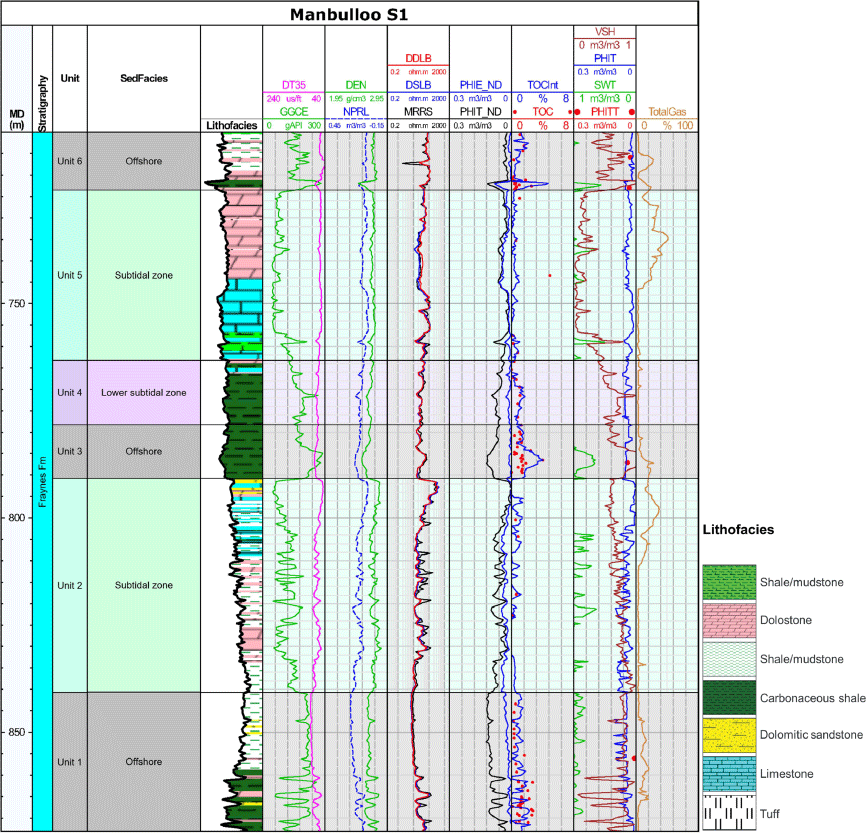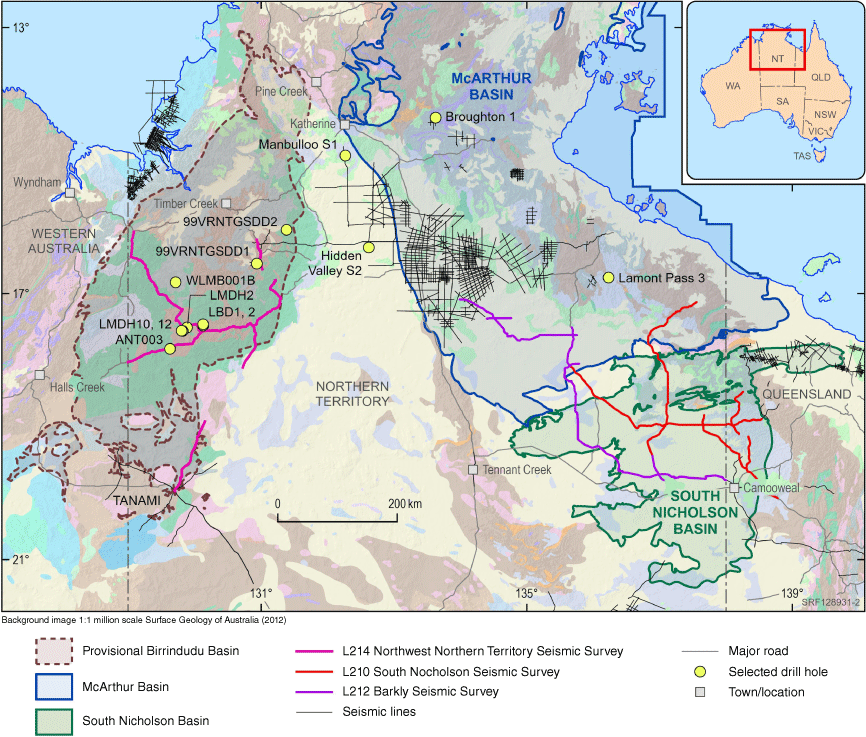Unconventional hydrocarbon prospectivity of the Paleoproterozoic Fraynes Formation in Manbulloo S1, Northern Territory
Liuqi Wang A * , Adam H. E. Bailey A , Emmanuelle Grosjean A , Tehani Palu A , Chris Carson A , Lidena K. Carr A , Jade Anderson A , Grace Butcher A , Chris Southby A and Paul A. Henson AA

Liuqi Wang is a Well Analyst at Geoscience Australia working in the Minerals, Energy and Groundwater Division. His research interests include petrophysics, static and dynamic reservoir modelling, applied statistics and artificial intelligence. He is a member of PESA and EAGE. |

Adam H. E. Bailey is a Petroleum Geoscientist at Geoscience Australia, with expertise in petroleum geomechanics, structural geology and basin analysis. He graduated with PhD in 2016 from the Australian School of Petroleum at the University of Adelaide. Adam is currently part of the Onshore Energy Systems team at Geoscience Australia, where he currently works on the Exploring for the Future program. |

Emmanuelle Grosjean is an Organic Geochemist at Geoscience Australia working in the Minerals, Energy and Groundwater Division. Emmanuelle applies organic geochemistry to assess the hydrocarbon prospectivity of Australia’s offshore and onshore sedimentary basins. Emmanuelle holds a doctorate degree in organic chemistry from the University of Strasbourg, France. Before joining Geoscience Australia in 2005, she worked on the Precambrian petroleum systems of the South Oman Salt Basin as a post-doctoral associate at the Massachusetts Institute of Technology. |

Tehani J. Palu (nee Kuske) holds a Master’s in Earth Science with first-class honours from the University of Waikato, New Zealand, and has been with Geoscience Australia since 2009. Tehani has been a Petroleum Systems Analyst in the Onshore Energy Systems team since 2014 at Geoscience Australia after working on several other related projects including carbon capture and storage monitoring and offshore acreage release. |

Chris Carson has worked in Antarctica, Canadian Arctic, Alaska, New Caledonia and northern and central Australia, specialising in metamorphic petrology, geochronology and structural geology. Joining Geoscience Australia in 2006 he dabbled in SHRIMP geochronology and, in 2017, joined the Onshore Energy program, working in the South Nicholson region of the NT. |

Lidena K. Carr is a geoscientist for the Onshore Energy Systems Project within the Resources Division at Geoscience Australia. She graduated from the Australian National University (ANU) majoring in Geology and Human Ecology with a BA/BSc (Hons) in 2004, and began working as a technical officer at the Research School of Earth Sciences (ANU). In 2007, she joined Geoscience Australia with the then ACRES (satellite imagery), in 2009, she moved to the then Onshore Energy and Mineral Division to work as a seismic interpreter and basin analyst. Currently, she is the Acting Director of the Onshore Energy Systems directorate working on the Exploring for the Future program. She is a member of PESA and GSA. |

Jade Anderson works as a Geoscientist in basin systems at Geoscience Australia. She completed a PhD at the University of Adelaide in 2015, in the areas of metamorphic geology, geochronology and Proterozoic Australia tectonics. |

Grace Butcher is a Geologist at Geoscience Australia. She graduated with a BSc (Hons) in 2010 from the School of Earth and Environment at the University of Leeds. Working with the Onshore Energy Systems team at Geoscience Australia. Grace is currently working on the flagship Exploring for the Future program in Northern Australia, specifically the NDI Carrara 1 drill hole and newly discovered Carrara Sub-basin. |

Chris Southby is a geoscientist in the Geoscience Australia Resources Division, Energy Systems Branch. He completed his Honours at Australian National University in 2004, on paleo-climate geochemistry of corals from Papua New Guinea. Since joining Geoscience Australia in 2008 he has contributed to a number of projects including the National Carbon Mapping and Infrastructure Plan, the Vlaming Sub-basin CO2 Storage Assessment, and the Houtman Sub-basin Prospectivity Project. He is now part of the Onshore Energy Systems team at Geoscience Australia, currently working under the Exploring for the Future project initiative. |

Paul A. Henson graduated from the University of Tasmania and is currently Director of the Onshore Energy Systems Section at Geoscience Australia. He has extensive experience in the minerals sector working on mineral systems in Proterozoic and Archaean terranes. Since 2010 he led the Australian Governments’ onshore carbon storage program, undertaking deep onshore drilling and seismic acquisition programs in collaboration with the states and industry. In addition, he now manages the Exploring for the Future – Energy Program leading a team of researchers to acquire new pre-competitive geoscientific data to improve our understanding of the oil and gas potential of Australian onshore basins. |
Abstract
The Paleoproterozoic Fraynes Formation in the Birrindudu Basin is a chronostratigraphic equivalent to the prospective Barney Creek Formation in the McArthur Basin and yet a comparable understanding of its source potential is lacking. As part of Geoscience Australia’s Exploring for the Future program, this study aims to assess the hydrocarbon generating potential and shale gas prospectivity of the Fraynes Formation in the exploration drill hole Manbulloo S1 through the reconstruction of the original source-rock characteristics and well log interpretation. Internal units inside the Fraynes Formation were defined according to sedimentary facies. The hydrocarbon generation potential was estimated from the calculated original total organic carbon content, hydrogen index and thermal maturity data measured from bitumen reflectance data. The shale total porosity was re-interpreted from bulk density logs by removing the organic matter effect, adding organic porosity for the organic-rich shales, and updating the water saturation. The maximum amount of gas generated from the organic-rich source rocks is 3969, 2769 and 1912 Mcf/a-ft assuming the kerogen compositions of 100% Type I, mix of 50–50% Type I and II, and 100% Type II, respectively. The richness of organic matter and interpreted water saturation (<100%) imply favourable shale gas prospectivity in the Fraynes Formation. This work expands our knowledge on the potential unconventional energy resources in the west of the greater McArthur Basin.
Keywords: Exploring for the Future, Fraynes Formation, generated gas, greater McArthur Basin, Northern Territory, paleoproterozoic, petrophysical interpretation, shale gas, total organic carbon, unconventional hydrocarbon prospectivity.
Introduction
The greater McArthur Basin is an informal term for the Paleo-Mesoproterozoic sedimentary system that includes the McArthur Basin, the Birrindudu Basin and the Tomkinson Province in the Northern Territory. Geophysical, lithological and geochronological data provide evidence that the McArthur and Birrindudu basins are connected in the subsurface (Subarkah et al. 2023). While the McArthur Basin has been the focus of extensive studies in recent years (Munson et al. 2020), the Birrindudu Basin is comparatively underexplored, and its resource potential is poorly understood despite hosting rocks of similar age. In particular, the Fraynes Formation in the upper Limbunya Group of the Birrrindudu Basin dated as 1642.2 ± 3.9 Ma by U–Pb zircon SHRIMP testing is currently interpreted as a chronostratigraphic equivalent to the prospective Barney Creek Formation of the McArthur Basin (Munson et al. 2020). The Barney Creek Formation is the primary source rock for the McArthur Petroleum Supersystem with conventional and unconventional gas discoveries encountered in numerous wells in the Northern Territory (Jarrett et al. 2022). The Fraynes Formation may therefore be a source rock of interest to explorers in the Birrindudu Basin. This study focusses on assessing the hydrocarbon-generating potential and shale gas prospectivity of the Fraynes Formation as intersected in Pangaea Resources’ drill hole Manbulloo S1 spudded in 2014. While Manbulloo S1 is located outside of the provisional Birrindudu Basin outline (Fig. 1), seismic data strongly imply that this drill hole intersects units at depth interpreted to be equivalent to units within the Birrindudu Basin. This study uses organic and inorganic geochemical properties collected from well completion reports (Pangaea 2015a, 2015b) and petrophysical property testing conducted by Geoscience Australia on preserved Manbulloo S1 core samples to make a preliminary assessment of the unconventional hydrocarbon prospectivity of the Fraynes Formation.
Hydrocarbon generating potential in the Fraynes source rocks
Crombez et al. (2023) concluded that the sedimentary facies of the Fraynes Formation in Manbulloo S1 included offshore and subtidal zones. Six internal units within the Fraynes Formation were defined according to these sedimentary facies (Fig. 2).
Well data in Manbulloo S1. From left to right, track 1: measured depth (m); track 2: stratigraphy (Pangaea 2015a); track 3: internal units; track 4: sedimentary facies (SedFacies, Crombez et al. 2023); track 5: lithofacies; track 6: gamma ray (GGCE, gAPI) and compressional wave slowness (DT35, µs/ft); track 7: bulk density (DEN, g/cm3) and neutron porosity (m3/m3); track 8: deep (DDLB, Ωm) and shallow (DSLB, Ωm), and micro-resistivity (MRRS, Ωm); track 9: total (PHIT_ND, m3/m3) and effective porosity (PHIE_ND, m3/m3) interpreted from neutron-density crossplot; track10: laboratory measured present-day (TOC, wt%) and interpreted TOC content (TOCint, wt%); track 11: interpreted volume fraction of shale (VSH, m3/m3), total porosity (PHIT, m3/m3) and total water saturation (SWT, m3/m3), and laboratory measured total porosity (PHITT, m3/m3); track 12: total gas from mudlog, 1 unit = 1% of methane in air.

Thermal maturity
Fifteen cutting samples from Manbulloo S1 were used to measure bitumen reflectance (BRo, %) to assess the thermal maturity (Pangaea 2015b). The equation developed by Luo et al. (2021) was used to convert the bitumen reflectance to an equivalent vitrinite reflectance (EqVR, %) (Grosjean et al. 2023). The average EqVR of the Fraynes Formation is 1.68% in Manbulloo S1. The EqVR values indicate that the Fraynes source rocks are within the gas window (Ruble et al. 2016).
Hydrocarbon generating potential
The Proterozoic Fraynes Formation source rocks in Manbulloo S1 were deposited in a marine offshore to subtidal environment (Crombez et al. 2023). Three cases of kerogen types (Case 1: 100% Type I; Case 2: mix of 50–50% Type I–II; and Case 3: 100% Type II) were assumed as possible scenarios for computing the original hydrogen index (HIo). Pyrolysis source rock screening included the present-day total organic carbon (TOC) content, thermally extracted free hydrocarbons (S1), hydrocarbon generated by thermal degradation of the kerogen (S2), CO2 produced during pyrolysis of kerogen (S3), hydrogen index (HI) and production index (PI) (Pangaea 2015b). Rock density (ρb, g/cm3) was provided from density logs.
The original TOC content was derived from the present-day TOC content, transformation ratio, and residual carbon factor. The source rocks in the Fraynes Formation have the median and maximum TOC contents of 0.83 and 4.98%, respectively. The generative potentials for both oil and gas were estimated using the original TOC content, original hydrogen index and thermal maturity data (Ruble et al. 2016; Grosjean et al. 2023) with the calculated results shown in Table 1.
| Unit (depth, m) | Net shale thickness (m) | Present day TOC (wt%) | Kerogen type case | Generated oil (bbl/a-ft) | Generated gas (Mcf/a-ft) | |
|---|---|---|---|---|---|---|
| Average/maximum | Average/maximum | Average/maximum | ||||
| Unit 6 (709.5–723.5) | 7.3 | 1.62/2.59 | 1 | 163/259 | 1294/2171 | |
| 2 | 111/179 | 882/1501 | ||||
| 3 | 76/124 | 598/1035 | ||||
| Unit 5 (723.5–763.2) | 0.9 | 3.03/4.98 | 1 | 273/433 | 2463/3969 | |
| 2 | 190/302 | 1713/2769 | ||||
| 3 | 131/209 | 1183/1912 | ||||
| Unit 4 (763.2–778.3) | 4.7 | 1.08/1.1 | 1 | 99/101 | 1027/1053 | |
| 2 | 68/69 | 703.35/722 | ||||
| 3 | 47/48 | 482/496 | ||||
| Unit 3 (778.3–790.8) | 11.7 | 1.58/4.05 | 1 | 124/329 | 1373/3666 | |
| 2 | 83/230 | 924/2565 | ||||
| 3 | 55/161 | 611/1790 | ||||
| Unit 2 (790.8–833.8) | 3.8 | No organic-rich samples were tested. | ||||
| Unit 1 (833.8–873.2) | 20.1 | 1.65/2.78 | 1 | 99/177 | 1630/2904 | |
| 2 | 67/123 | 1101/2026 | ||||
| 3 | 45/86 | 734/1417 | ||||
| Fraynes Formation | 48.5 | 1.64/4.98 | 1 | 122/433 | 1511/3969 | |
| 2 | 83/302 | 1023/2769 | ||||
| 3 | 56/209 | 684/1912 | ||||
The average and maximum (in brackets) values calculated for the generated gas in the Fraynes Formation are 1511 Mcf/a-ft (3969 Mcf/a-ft), 1023 Mcf/a-ft (2769 Mcf/a-ft), and 684 Mcf/a-ft (1912 Mcf/a-ft) in the kerogen types of the three assumed cases. It is concluded that the Fraynes Formation shales have favourable hydrocarbon generating potential. In general, the offshore shales have higher generating potential than subtidal shales.
Petrophysical interpretation
Total organic carbon content
As an indication of organic matter richness in sedimentary rocks, TOC content is a critical parameter for assessing the hydrocarbon generation potential of source rocks and their adsorbed gas content. The presence of organic matter may increase resistivity, lower bulk density and increase transmission time of acoustic waves. In this study, the TOC content was interpreted from porosity and resistivity logs using Schlumberger’s Techlog™ platform.
The organic-rich, or net, shale was identified where TOC content is ≥1 wt% in the interpreted TOC content profiles. The net shale thickness for each internal unit of the Fraynes Formation in Manbulloo S1 is listed in Table 1, with the total interpreted net shale thickness being 48.5 m. In the organic-rich intervals, the median and maximum interpreted TOC contents are 1.43 and 4.84 wt%, respectively, while the median and maximum laboratory measured TOC contents are 1.64 and 4.98 wt%, respectively.
Volume fraction of shale, porosity and water saturation
Wireline log interpretation conducted for the Fraynes Formation included the derivation of volume fraction of shale from gamma-ray logs and neutron-density crossplot, total and effective porosity from neutron-density crossplot and water saturation from total porosity and formation resistivity using the dual water model in Techlog™. The formation water resistivity was derived using the resistivity ratio method.
Total density porosity of shale
Total porosity is a critical parameter for evaluating the gas storage capacity of shale. In a shale reservoir, organic matter behaves like porosity to logged bulk density. The interpretation of total density porosity for the organic-rich shales was conducted by removing the kerogen effect (Wang et al. 2023a, 2023b). Organic matter has abundant pores, which are significant for the storage capacity of adsorbed gas in shales. The organic porosity of the Fraynes Formation shales was estimated using the mass balance model (Peters et al. 2005; Wang et al. 2023b), and assuming the kerogen type is the mix of 50–50% Type I–II. The total water saturation was updated with the re-interpreted porosity and considering the influence of organic matter on resistivity logs (Wang et al. 2023b). The total porosity (PHITT) combines the neutron-density porosity (PHIT_ND) for non-organic-rich rocks and total density porosity for organic-rich shales (Fig. 2).
For the organic-rich shales, the average and maximum total density porosity are 3.43 and 5.29%, respectively, and the average and minimum water saturation are 92.8 and 49.5%, respectively. In addition, the high present day TOC content implies the probability of high adsorbed gas content (Wang et al. 2023b). The petrophysical interpretation highlights that the organic-rich Fraynes Formation shales have several characteristics that may imply favourable shale gas resource prospectivity, particularly considering both free and adsorbed gas content.
Conclusions
The hydrocarbon generating potential and shale gas prospectivity have been investigated for the Paleoproterozoic Fraynes Formation in Manbulloo S1 through the reconstruction of original source-rock generative potential and wireline log interpretation.
Thermal maturity data indicate that the Fraynes Formation shales are within the gas window. The maximum generated gas in the Fraynes Formation source rocks could be up to 3969, 2769 and 1912 Mcf/a-ft when assuming the kerogen compositions of 100% Type I, mix of 50–50% Type I and II, and 100% Type II, respectively where the offshore shales have higher generating potential than subtidal shales. Petrophysical interpretation for the organic-rich shales shows that net shale thickness is 48.5 m in the Fraynes Formation in Manbulloo S1, and the organic-rich shales have favourable shale gas prospectivity including both free and adsorbed gas contents.
Data availability
Well data for Manbulloo S1 are available from the Geoscience Exploration and Mining Information System (GEMIS) site, Northern Territory (https://geoscience.nt.gov.au/gemis/ntgsjspui/handle/1/83412 and https://geoscience.nt.gov.au/gemis/ntgsjspui/handle/1/90914). The petrophysical testing results are available from Geoscience Australia (http://ecat.ga.gov.au/geonetwork/srv/eng/catalog.search#/metadata/149135).
Declaration of funding
This study was funded by Geoscience Australia’s Exploring for the Future program. No funding from external organisations was received for this research.
Acknowledgements
We thank Dianne Edwards and Duy Nguyen for internal peer reviews at Geoscience Australia. This paper is published with the permission of the CEO, Geoscience Australia.
References
Crombez V, Schmid S, Fenselau K (2023) Sedimentological and petrophysical characterisation of the Birrindudu Basin, Northern Territory. NTGS RECORD 2023-008, Northern Territory Geological Survey. Available at https://geoscience.nt.gov.au/gemis/ntgsjspui/bitstream/1/92673/3/NTGSRec2023-008.pdf
Grosjean E, Jarrett AJM, Boreham CJ, Wang L, Johnson L, Hope JM, Ranasinghe P, Brocks JJ, Bailey AHE, Butcher GA, Carson CJ (2023) Resource potential of the Proterozoic–Paleozoic Carrara depocentre, South Nicholson region, Australia: Insights from stratigraphic drilling. Organic Geochemistry 186, 104688.
| Crossref | Google Scholar |
Jarrett AJM, Munson TJ, Williams B, Bailey AHE, Palu T (2022) Petroleum supersystems in the greater McArthur Basin, Northern Territory, Australia: Prospectivity of the world’s oldest stacked systems with emphasis on the McArthur Supersystem. The APPEA Journal 62, 245-262.
| Crossref | Google Scholar |
Luo Q, Zhang L, Zhong N, Wu J, Goodarzi F, Sanei H, Skovsted CB, Suchý V, Li M, Ye X, Cao W, Liu A, Min X, Pan Y, Yao L, Wu J (2021) Thermal evolution behavior of the organic matter and a ray of light on the origin of vitrinite-like maceral in the Mesoproterozoic and Lower Cambrian black shales: Insights from artificial maturation. International Journal of Coal Geology 244, 103813.
| Crossref | Google Scholar |
Munson TJ, Denyszyn SW, Simmons JM, Kunzmann M (2020) A 1642 Ma age for the Fraynes Formation, Birrindudu Basin, confirms correlation with the economically significant Barney Creek Formation, McArthur Basin, Northern Territory. Australian Journal of Earth Sciences 67(3), 321-330.
| Crossref | Google Scholar |
Pangaea (2015a) Basic well completion report, NT EP-167-Manbulloo-S1. Revision No. A and B. Available at https://geoscience.nt.gov.au/gemis/ntgsjspui/handle/1/83412
Pangaea (2015b) PR2016-W005_Enclosure_1_Laboratory_Results.zip and PR2016-W005_Enclosure_2_Petrophysical_Analysis.zip. Available at https://geoscience.nt.gov.au/gemis/ntgsjspui/handle/1/90914
Ruble T, Roberts E, Hankins B, Yee J (2016) Altree 2 Interpretive Summary. Upper Velkerri – Lower Velkerri Interval. Weatherford Laboratories Study Project No. AB-74329. Available at https://geoscience.nt.gov.au/gemis/ntgsjspui/bitstream/1/85085/3/CSR0413_Core_Sample_Report_Altree_2.pdf
Subarkah D, Collins AS, Farkaš J, Blades ML, Gilbert SE, Jarrett AJM, Bullen MM, Giuliano W (2023) Characterising the economic Proterozoic Glyde Package of the greater McArthur Basin, northern Australia. Ore Geology Reviews 158, 105499 ISSN 0169-1368.
| Crossref | Google Scholar |
Wang L, Bailey AH, Grojean E, Carson C, Carr LK, Butcher G, Boreham C, Southby C, Henson PA (2023a) Data analysis and interpretation of well logs in NDI Carrara 1, Northern Territory. In ‘Australasian Exploration Geoscience Conference (AEGC) 2023 Extended Abstracts’, 13–18 March 2023, Brisbane, Qld. (Australian Society of Exploration Geophysicists)
Wang L, Bailey AHE, Grojean E, Carson C, Carr LK, Boreham C, Butcher G, Henson PA (2023b) Wireline log data analysis in NDI Carrara 1, Northern Territory. Record 2023/26. Geoscience Australia, Canberra. 10.26186/147880
 Liuqi Wang is a Well Analyst at Geoscience Australia working in the Minerals, Energy and Groundwater Division. His research interests include petrophysics, static and dynamic reservoir modelling, applied statistics and artificial intelligence. He is a member of PESA and EAGE. |
 Adam H. E. Bailey is a Petroleum Geoscientist at Geoscience Australia, with expertise in petroleum geomechanics, structural geology and basin analysis. He graduated with PhD in 2016 from the Australian School of Petroleum at the University of Adelaide. Adam is currently part of the Onshore Energy Systems team at Geoscience Australia, where he currently works on the Exploring for the Future program. |
 Emmanuelle Grosjean is an Organic Geochemist at Geoscience Australia working in the Minerals, Energy and Groundwater Division. Emmanuelle applies organic geochemistry to assess the hydrocarbon prospectivity of Australia’s offshore and onshore sedimentary basins. Emmanuelle holds a doctorate degree in organic chemistry from the University of Strasbourg, France. Before joining Geoscience Australia in 2005, she worked on the Precambrian petroleum systems of the South Oman Salt Basin as a post-doctoral associate at the Massachusetts Institute of Technology. |
 Tehani J. Palu (nee Kuske) holds a Master’s in Earth Science with first-class honours from the University of Waikato, New Zealand, and has been with Geoscience Australia since 2009. Tehani has been a Petroleum Systems Analyst in the Onshore Energy Systems team since 2014 at Geoscience Australia after working on several other related projects including carbon capture and storage monitoring and offshore acreage release. |
 Chris Carson has worked in Antarctica, Canadian Arctic, Alaska, New Caledonia and northern and central Australia, specialising in metamorphic petrology, geochronology and structural geology. Joining Geoscience Australia in 2006 he dabbled in SHRIMP geochronology and, in 2017, joined the Onshore Energy program, working in the South Nicholson region of the NT. |
 Lidena K. Carr is a geoscientist for the Onshore Energy Systems Project within the Resources Division at Geoscience Australia. She graduated from the Australian National University (ANU) majoring in Geology and Human Ecology with a BA/BSc (Hons) in 2004, and began working as a technical officer at the Research School of Earth Sciences (ANU). In 2007, she joined Geoscience Australia with the then ACRES (satellite imagery), in 2009, she moved to the then Onshore Energy and Mineral Division to work as a seismic interpreter and basin analyst. Currently, she is the Acting Director of the Onshore Energy Systems directorate working on the Exploring for the Future program. She is a member of PESA and GSA. |
 Jade Anderson works as a Geoscientist in basin systems at Geoscience Australia. She completed a PhD at the University of Adelaide in 2015, in the areas of metamorphic geology, geochronology and Proterozoic Australia tectonics. |
 Grace Butcher is a Geologist at Geoscience Australia. She graduated with a BSc (Hons) in 2010 from the School of Earth and Environment at the University of Leeds. Working with the Onshore Energy Systems team at Geoscience Australia. Grace is currently working on the flagship Exploring for the Future program in Northern Australia, specifically the NDI Carrara 1 drill hole and newly discovered Carrara Sub-basin. |
 Chris Southby is a geoscientist in the Geoscience Australia Resources Division, Energy Systems Branch. He completed his Honours at Australian National University in 2004, on paleo-climate geochemistry of corals from Papua New Guinea. Since joining Geoscience Australia in 2008 he has contributed to a number of projects including the National Carbon Mapping and Infrastructure Plan, the Vlaming Sub-basin CO2 Storage Assessment, and the Houtman Sub-basin Prospectivity Project. He is now part of the Onshore Energy Systems team at Geoscience Australia, currently working under the Exploring for the Future project initiative. |
 Paul A. Henson graduated from the University of Tasmania and is currently Director of the Onshore Energy Systems Section at Geoscience Australia. He has extensive experience in the minerals sector working on mineral systems in Proterozoic and Archaean terranes. Since 2010 he led the Australian Governments’ onshore carbon storage program, undertaking deep onshore drilling and seismic acquisition programs in collaboration with the states and industry. In addition, he now manages the Exploring for the Future – Energy Program leading a team of researchers to acquire new pre-competitive geoscientific data to improve our understanding of the oil and gas potential of Australian onshore basins. |



